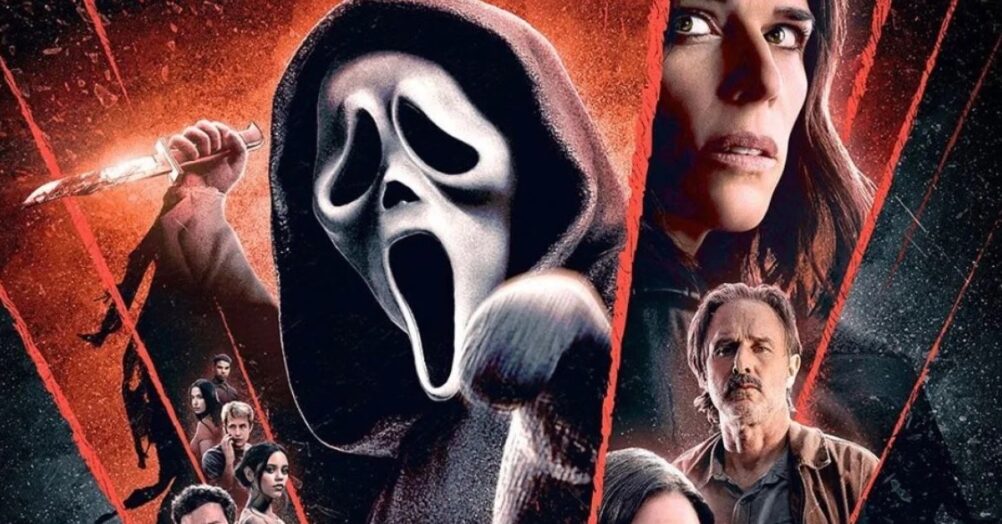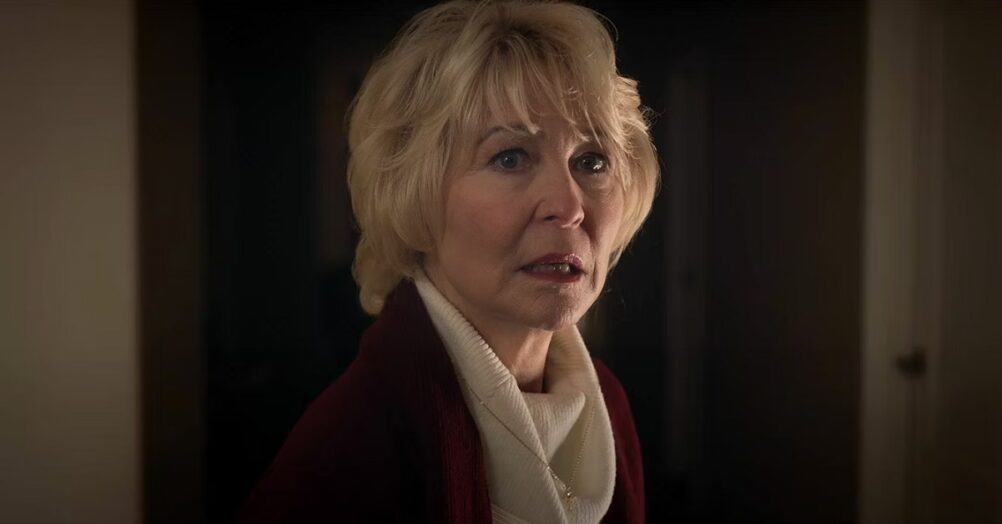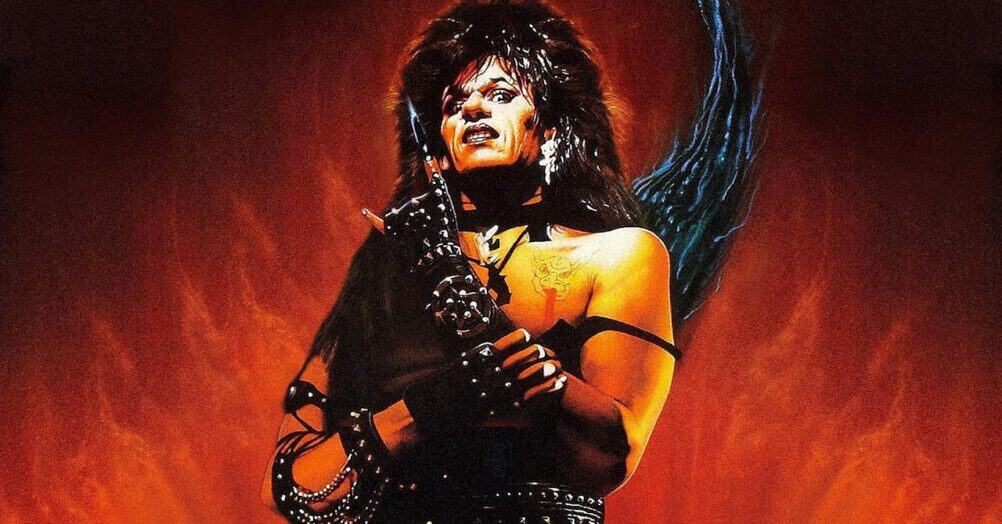Last Updated on November 21, 2024
What if I told you that the late directing legend George Romero wrote and directed an ahead-of-its-time “one bad day” revenge slasher classic back in 2000 that mixed Michael Douglas in Falling Down with Michael Myers from Halloween and featured a live performance by The Misfits… yet no one noticed? It would take Robert Stack and a special episode of Unsolved Mysteries to uncover how a film that was arguably one of George Romero’s best films in the second half of his career went completely unnoticed, and stayed that way even as we speak today… This is just what happened to Bruiser.
Look for yourself and you’ll find a very thin file on the existence of Bruiser (watch it HERE). To craft even the video you’re watching right now we had to reach into the time vault of eBay and find a DVD copy featuring a commentary from Romero and his frequent collaborator producer Peter Grunwald to learn about the movie.
In the film, Romero writes the story of a mild-mannered and empathetic man named Henry Creedlow. Henry works at a fashion magazine called Bruiser with an overbearing narcissistic boss and then comes home at the end of the day to a money-hungry, dehumanizing wife and their half-finished home he can’t afford. He’d talk to his best friend and financial advisor about it, but he’s too busy stealing Henry’s money on the side and flaunting it in his face. “I thought there’d be more… I always think there will be more” Henry says as his supposed friend gives him the bad news about his finances. After hearing a caller on a radio program kill himself live on air one morning, Henry starts to feel a change deep within himself.
With every personal slight, he begins to have visions of himself doing copious amounts of harm to others in return. A lady who cuts him off on the train gets punched in the face and thrown on the tracks where the train runs over her head. Later, moments after he sees his wife giving his asshole boss his very own “job” poolside, he imagines driving an axe into her head. He’s not doing great and the world around him just keeps pushing him like those cops did Rambo in First Blood. One day, his only true friend hands him a blank, white mask and asks him to decorate it with his personality. He stares at it, unable to complete the task because he is empty inside. Then, he wakes up and finds that the mask has molded to his face and he is unable to remove it, giving him a blank face. His fantasies then begin to blur with the real world and he murders a woman he catches stealing from his home. Then he murders his wife when he catches her banging his boss. Finally, with the cops on his heels, he tracks his larger-than-life dick of a boss down to a huge Halloween party where The Misfits happen to be playing for his big finale.

The film would be the very first time in George Romero’s illustrious career that he wouldn’t be filming in Pittsburgh as Bruiser was instead filmed in Toronto, Canada. As a matter of fact, there are a lot of differences in the making of Bruiser that would contrast with Romero’s typical work. Something you have to imagine he welcomed after a string of films that didn’t go the way he’d have liked for various reasons. Bruiser would come fifteen years after his last (at the time) zombie film in Day of the Dead and would follow the TV short Iron City Asskickers, his adaption of Stephen King’s The Dark Half, a segment of Two Evil Eyes, Monkey Shines, and of course The Misfits music video he directed for their song Scream! This is actually where Romero recruited the famous punk band for the film. The Misfits’ own Jerry Caiafa, would explain, “For this new video, we have a song called ‘Scream!’ that was written for Wes Craven and his movies… and we were looking for a video to get done for it so we called George and asked him if he was interested and he said he would do it and he needed us to be in his movie. So we actually exchanged working atmospheres. He’s gonna direct our video, and we’re going to be in his movie. Just doing each other favors so, we’re very excited about it”
The band isn’t just playing in the background, either. There are many shots of them in the final set piece of the film that includes them beating up on unruly audience members and playing multiple songs on stage. It’s awesome and in this guy’s opinion, totally underrated in the zeitgeist of horror and punk. Not to mention how punk rock George Romero is for directing a Misfits video, then asking that his only payment be their appearance in his film. What a legend.
Speaking of legendary directors, this isn’t the only time in the making of Bruiser that Wes Craven’s name was mentioned. In fact, Romero, in an interview during the filming of his Misfits video, gave credit to Craven’s Scream for bringing horror to the forefront again, saying: “I’m sure Scream is what really brought the genre back. Brought the horror genre back. So it’s thanks to Wes and Kevin Williamson and those guys that made a couple movies that went out and made hundreds of millions of dollars. It’s always been a copycat business. And so that’s the resurgence. Then what happens is exactly what you see there’s some other independents like Blair Witch and then you have Sixth Sense and Hollywood sort of movies that come after. Then when the big movies don’t make as much as the little movies, they decide that horror is not the business to be in and horror will go down again until somebody makes a little movie that makes a hundred million bucks.”
While true, this resurgence in horror turned out to be a Catch-22 for Romero, who saw Bruiser not as a horror film, but more the dramatic story of a man going through a difficult time in his life. During a later DVD commentary for Dawn of the Dead, Romero remarked that the marketing of Bruiser as a pure horror film is a part of the reason it ended up going directly to video, rather than movie theaters where it belonged.
While fans of Bruiser and of course, Romero himself probably wish it had a chance to be more successful, this doesn’t mean he is not proud of his work on the film, nor that he had a bad time creating it. In fact, during the commentary he and Grunwald marvel non-stop at the crew they worked with. Most specifically, the work of the camera crew and cinematographer Adam Swica (who would also work on films such as Wrong Turn, and A Haunting in Connecticut) who the pair would say took a few million bucks and made it look like ten.

There were many aspects of filming Bruiser, that were foreign to Romero’s style at the time. The film required much more pre-planning than he was used to because the plot was constantly moving and they had a very short window in which to film. According to Romero, the crew was constantly professional, not only being accommodating but adding their visual creativity to each shot. And I have to tell you, watching the film with that in mind gives a new respect for how difficult some of those shots were to pull off, including multiple one-track moments.
Romero mentions that Bruiser was one of his favorite productions he’d worked on in all of his career. Despite the difficult shots, limited time to shoot, and modest budget… he mentioned that the financiers of the film stayed completely out of their way throughout the shoot. Something he was not used to in his later years in Hollywood. There were no excuses for the lack of success for Bruiser either, he stated proudly that because of the crew’s dedication to the script, this was in the top three films of his career that captured what he set out to accomplish. Right up there with Knightriders and Martin according to the director. Romero would proudly exclaim, Bruiser “The only movie I’ve ever made where you don’t have any problems, where nobody was in the way or had their own axe to grind. I could relive every moment of this again.” He even exclaimed that the “weapons guy” was the best weapons guy he’d worked with in his career, adding, “Where was he when I made Dawn of the Dead?” while laughing. Some things just worked out for George and Company on the set of Bruiser.
Most of the sets were found almost as is and needed only a little dressing up by the set decorator rather than having to be built from scratch. These included Harry’s lavish half-finished house which was found and offered up by the location director. A home in which the family who owned it lived in the basement even as they shot Bruiser. They were allegedly not familiar with Romero’s work and would “run the other direction” whenever they spotted blood on the set of the house, which the producer found hilarious. The table-saw from the home wasn’t originally in the script but Romero found it cool and wrote it into the story. Because you’re not going to NOT use a badass table-saw in a horror movie.
The mask that makes Bruiser so memorable, however, was not an easy road for the crew. The mask inspired by the 1960 Georges Franju film Eyes Without a Face had originally been written in the script as a flesh-colored mask whose physical attributes more resembled the mold in the building stages of a mask. They even shot several scenes of the film and had to go back and refilm them after they realized the stark white nature of the new mask, resembling how empty he was inside, was perfect for the story. And it truly is haunting. It’s a shock to see the mask from the cover of the film be so malleable on the actor’s face, moving enough for him to speak and emote. A truly underrated horror mask. That’s not to say it wasn’t rather tight, however, as they even had to build little cups inside of the eyelids to allow the actor to blink. An actor who had to be willing to sit for hours in makeup each day to bring the character of Henry to life… which would of course be none other than Bobby Beers from Rock Star, Jason Flemyng.
Flemyng was fantastic for the role, able to exude both a nice guy persona and more importantly be believable when he turned heel. Of Flemyng’s work ethic Romero stated “he was in basically every shot of the movie but always in good spirits. Always cracking everybody up”. George would also go on to say that it is Flemying’s vulnerability that sells the entire movie and I would have to agree. Then there’s his counterpart, played by the man who played Satan across from Keanu Reeves in Constantine, the great Peter Stormare.

Stormare takes to the character of Miles Styles like Robert Downey Jr. to Iron Man. It’s damn near impossible to see anyone else playing the role that brings to mind some of Gary Oldman’s amazingly over-the-top performances in movies like True Romance, Leon The Professional, and The Fifth Element. He’s not just an asshole character you love to hate, he’s a flaming bag of assholes holding sparklers during someone else’s moment of silence. And it’s hilarious. He was so perfect for the role in fact, that Romero originally had the character as a brash, New York type of guy in the script but changed him to match Stormare’s bravado entirely. Stormare was so into the role that he would ad-lib many, many parts of his performance, including one moment in a board room where he storms around the room discussing the need for “balls” and repeatedly, unexpectedly revealing his man-parts to the entire room. Peter Grunwald said during the commentary that the “thud” sound you heard during the flashing was one of the people behind the camera falling over in shock. Sounds like Stormare would have been a walking lawsuit in 2024 as he also ad-libbed shoving a person he was in mid-conversation with into a pool. Everyone seemed to be a good sport however, and Romero and Grunwald seemed to love it, saying, “You never knew what he was gonna do. He would go off in between takes, get an idea, and come out and run with it. Made it now and then a little difficult to edit, but it was really well worth it just for the constant creative energy.” They said when Stormare would walk on set they would have to tie everything down, or else it would blow away.
Nina Garbiras was cast as Henry’s unnecessarily mean two-timing wife Janine, bringing some depth to a character that could have easily felt one note otherwise. And of course, the great Tom Atkins was cast as the detective investigating the case and even complained jokingly to the producers “When are you going to give me a role that’s not a cop?” Though he was playing Detective McCleary, a cop in the background chasing the plot around, he wasn’t without his patented Tom Atkins moments or quotes. McCleary’s investigation led him to the aforementioned warehouse Halloween party that had originally been written as a boat chase scene taking place on an island. This was changed due to budgetary restraints and probably for the best. A John Woo Face/Off style ending would have just felt wrong here… someone like being shot in the d*ck with a laser while The Misfits played was far more apropos. To pull off the warehouse scene they shot in an abandoned liquor distillery, told the extras to just show up looking as bizarre as they could, and had three units shooting nonstop all day long for five days. Romero praised The Misfits for being ridiculously helpful on the film, not only writing two songs for it but also bringing their entire stage setup with them for the set.
Once Henry had achieved his revenge on Miles Styles by shooting him in the crotch and head with a laser built for the party, his face suddenly appeared again… which led to the question for the audience of whether or not this was all in his head. Romero confirmed as much saying, “In my mind, it’s in his head. Again like Martin. Martin isn’t really a vampire. He just happens to drink blood. The way that I… if you look at all the moments where people see him there’s always a little amazement. I was thinking (it was) because he was bloody… but never a clear moment where somebody said ‘God, your face has turned white’.”
While Bruiser ended up with an unceremonious release to DVD after a premiere in Canada in February of 2000, it was at the very least appreciated by some critics with a “Fresh” score on Rotten Tomatoes. But if you needed any other indication the film feels unfairly forgotten, that score is based on a mere nine reviews. But hey, it’s never too late for a film to become a cult classic. But for now, I guess this underrated George Romero film will just have to be for me and you. And that my friends, is what happened to Bruiser. Thanks for watching!
A couple of the previous episodes of What Happened to This Horror Movie? can be seen below. To see more, head over to our JoBlo Horror Originals YouTube channel – and subscribe while you’re there!




















Follow the JOBLO MOVIE NETWORK
Follow us on YOUTUBE
Follow ARROW IN THE HEAD
Follow AITH on YOUTUBE